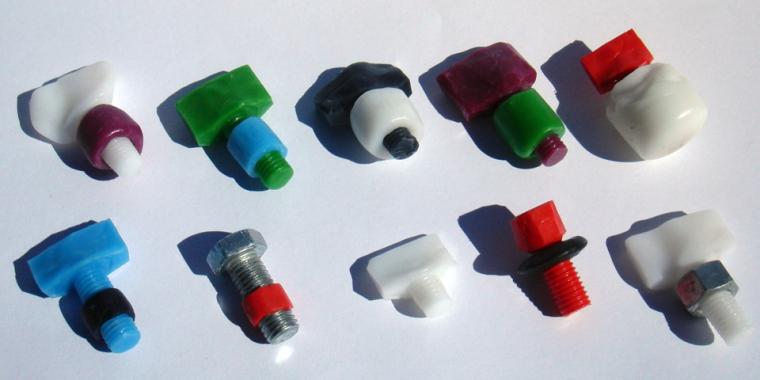Moulding
Casting Plastimake into a mould is a useful alternative to shaping it with your hands. There are many kinds of projects that are easier to achieve with a mould, such as:
- Making multiple identical parts
- Making items with fine details, flat surfaces or square edges
- Making a precise replica of an existing object
We recommend using Plastimake Moulding Formula for making moulds and casting into moulds. When heated to 60°C it becomes quite soft so you can easily push it into the fine details of your mould.
Make an outer mould
To make an outer mould of an object, simply form Plastimake around part of the object and let it cool. Take care to leave enough space so that you can remove your object from the Plastimake mould once it has cooled.
Once you have created an outer mould you can cast a range of materials in it. You can even cast Plastimake into a Plastimake mould, as we’ll see below.
Tips:
- Plastimake is slightly flexible, but nowhere near as flexible as traditional soft silicone moulds. You cannot create a Plastimake mould that wraps all the way around an object in the same way that a silicone mould does – you won’t be able to remove your item from the mould!
- Plastimake won’t stick to most metal and ceramic surfaces, but it will stick to some plastics. Apply a thin layer of Vaseline, oil or another mould release agent if you’re concerned that Plastimake might stick to the item you’re making a mould of.
Casting Plastimake into a Plastimake mould
This is the really exciting part! It’s possible to replicate an object by making an outer Plastimake mould of the object, then casting Plastimake into that mould.
Plastimake is not runny enough to pour directly into the mould. Instead, you need to push it into the mould using your hands to ensure it gets into all the details.
It’s important to make sure the Plastimake casting doesn’t fuse with the outer Plastimake mould. There are a few simple precautions you can take to ensure this doesn’t happen:
- Put the outer Plastimake mould in your freezer one hour before casting warm Plastimake into it. This ensures the outer mould never reaches 60°C, and therefore it won’t soften and stick to the internal casting.
- Use a small amount of Vaseline, oil, or another mould release agent inside the mould. This acts as a thin barrier between the mould and the casting.
Examples:
- Making functional nuts and bolts
- Replicating a ceramic face
- Making a hand mould
- Replicating a camera tripod component
Using Plastimake in other moulds
Plastimake works really well in a variety of commercially available moulds such as silicone ice-cube and cake-icing moulds. Simply push some warm Plastimake into the mould with your hands.
Really soft moulds like those designed for plaster casting can be difficult to use with Plastimake. The force required to push Plastimake into the details will distort the mould.
Examples:








